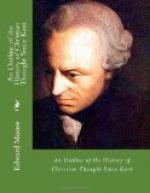are mainly taken from the Apologia, written
long after Newman had gone over to the Roman Church.
They perfectly describe the attitude of his mind toward
the Anglican Church, so long as he believed this, and
not the Roman, to be the true Church. He had once
thought that a man could hold a position midway between
the Protestantism which he repudiated and the Romanism
which he still resisted. He stayed in the via
media so long as he could. But in 1839 he
began to have doubts about the Anglican order of succession.
The catholicity of Rome began to overshadow the apostolicity
of Anglicanism. The Anglican formularies cannot
be at variance with the teachings of the authoritative
and universal Church. This is the problem which
the last of the Tracts, Tract Ninety,
sets itself. It is one of those which Newman wrote.
One must find the sense of the Roman Church in the
Thirty-Nine Articles. This tract is prefaced
by an extraordinary disquisition upon reserve in the
communication of religious knowledge. God’s
revelations of himself to mankind have always been
a kind of veil. Truth is the reward of holiness.
The Fathers were holy men. Therefore what the
Fathers said must be true. The principle of reserve
the Articles illustrate. They do not mean what
they say. They were written in an uncatholic age,
that is, in the age of the Reformation. They
were written by Catholic men. Else how can the
Church of England be now a Catholic Church? Through
their reserve they were acceptable in an uncatholic
age. They cannot be uncatholic in spirit, else
how should they be identical in meaning with the great
Catholic creeds? Then follows an exposition of
every important article of the thirty-nine, an effort
to interpret each in the sense of the Roman Catholic
Church of to-day. Four tutors published a protest
against the tract. Formal censure was passed upon
it. It was now evident to Newman that his place
in the leadership of the Oxford Movement was gone.
From this time, the spring of 1841, he says he was
on his deathbed as regards the Church of England.
He withdrew to Littlemore and established a brotherhood
there. In the autumn of 1843 he resigned the
parochial charge of St. Mary’s at Oxford.
On the 9th of October 1845 he was formally admitted
to the Roman Church. On the 6th of October Ernest
Renan had formally severed his connexion with that
Church.
It is a strange thing that in his Essay on the Development of Christian Doctrine, written in 1845, Newman himself should have advanced substantially Hampden’s contention. Here are written many things concerning the development of doctrine which commend themselves to minds conversant with the application of historical criticism to the whole dogmatic structure of the Christian ages. The purpose is with Newman entirely polemical, the issue exactly that which one would not have foreseen. Precisely because the development of doctrine is so obvious, because no




